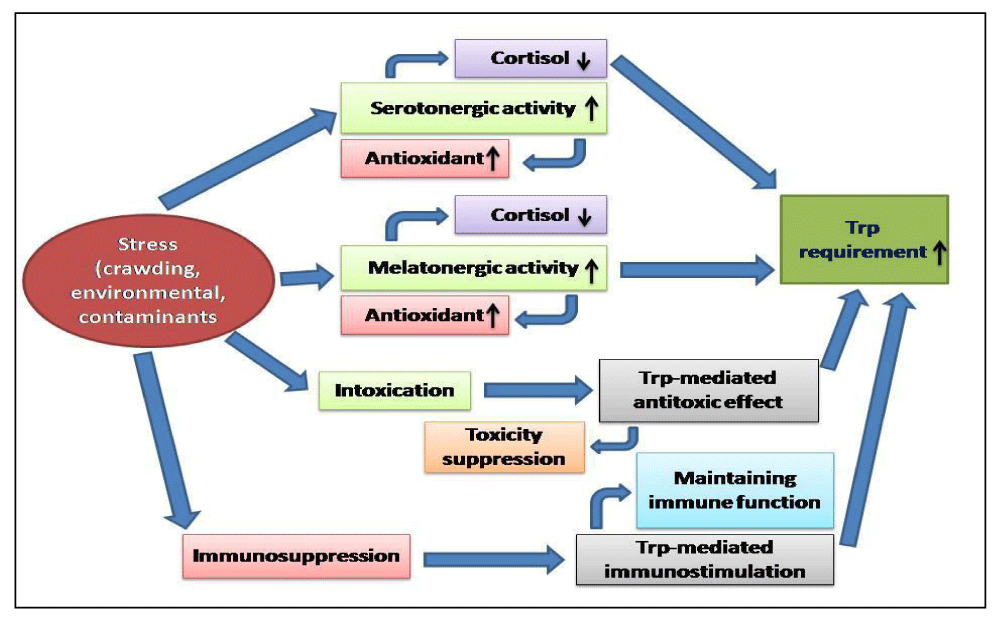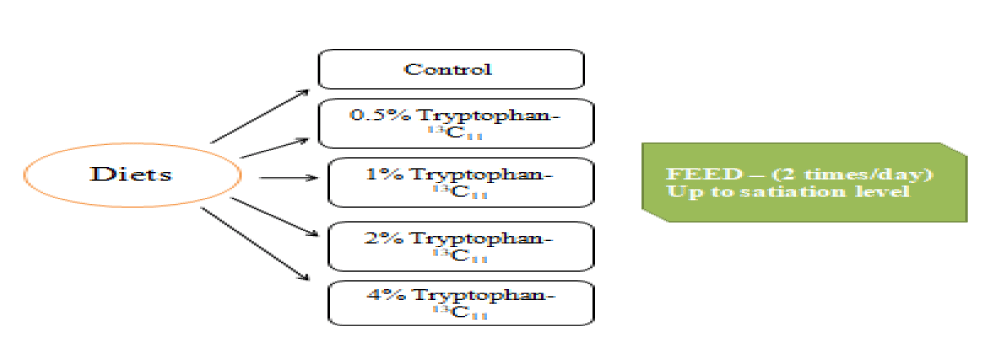Quantitative Research in Plant Methods
Tryptophan-13C11 Supplementation and its Effects on Cannibalism, Growth and Survival of Ompokbimaculatus Post-larvae
Anamika Debnath1, Suparna Deb2* and Pradyut Biswas3
1PhD, Scholar, Department of Aquaculture, West Bengal University of Animal & Fishery Sciences, India
2PhD, Scholar, Department of Aquaculture, College of Fisheries, CAU(I), Lembucherra, Tripura, India
3Assistant professor, Department of Aquaculture, College of Fisheries, CAU(I), Lembucherra, Tripura, India
Cite this as
Debnath A, Deb S, Biswas P. Tryptophan-13C11 Supplementation and its Effects on Cannibalism, Growth and Survival of Ompokbimaculatus Post-larvae. Quant Res Plant Methods. 2024;1(1):001-005. Available from: 10.17352/qrpm.000001Copyright Licence
© 2024 Debnath A, et, al. This is an open-access article distributed under the terms of the Creative Commons Attribution License, which permits unrestricted use, distribution, and reproduction in any medium, provided the original author and source are credited.This study examined how Tryptophan-13C11 supplementation to the diet of Ompokbimaculatus post larvae affects cannibalism, survival, and growth.
- Experiment: Post larvae were fed diets with varying Tryptophan-13C11levels (0%, 0.5%, 1%, 2%, 4%) for 30 days.
- Stocking density: 10 days old post-larvae were stocked @ 10 post-larval-1
- Experimental period: 30 days
Findings:
- Tryptophan-13C11 increased serotonin levels in the fish and slightly decreased growth rate.
- Survival rates were higher in groups fed Tryptophan-13C11diets.
Conclusion: Dietary Tryptophan-13C11 can be a useful tool to improve survival rate in O. bimaculatus post larvae rearing. However, it may slightly impact growth rates.
Introduction
Aquaculture stands out as the most rapidly expanding sector within agriculture, boasting considerable growth prospects. The global population is rapidly increasing and is expected to increase by another 2 billion, totaling 9.7 billion people by 2050. To meet the rising demand, the food production sector, particularly aquaculture has expanded dramatically, contributing 82.10 M t y-1 during 2018 [1] and now in 2024 it reaches up to 130.9 million tonnes [2]. In India, catfish have enormous potential, and the government of India has highlighted the diversification of agriculture practices as a national priority. In this context, the seed production and culture technology of catfishes needs to be improved for upgrading to the viable level. Among catfishes, Ompokbimaculatus [3] popularly known as Indian butter catfish or “Pabda”, is an Indigenous freshwater small fish belonging to the family Siluridae of the order Siluriformes, fit best to be considered as a prominent species which can be used for furthering the species diversification. Catfish is delicious and highly-priced because of its unique lipoprotein texture with soft bones, good taste, and higher nutritional profile [4]. It is well preferred, especially in the entire East and North East India. The government of Tripura has declared the fish (Ompokbimaculatus) as “STATE FISH” in collaboration with NBFGR, Lucknow. It has not received much attention due to the insufficiency of gravid stock for experimentation in aquaculture and also because of a shortage of information regarding its breeding protocol, larval rearing, and culture technology [4,5]. Mortality in aquaculture settings significantly contributes to aggression and cannibalism, even where conditions appear to be ideal [6,7]. The current study has focused on a nutritional approach using dietary tryptophan to reduce cannibalism during seed rearing of O. bimaculatus. Tryptophan (TRP) is a precursor of serotonin (5-HT) (Figure 1), which is known to affect food intake and aggression in vertebrates including fishes. It has been found that dietary supplementation with the serotonin precursor; L-tryptophan (TRP) suppresses aggression. TRP supplementation in fish feed boosts serotonin synthesis in the brain, which typically results in increased stress resistance [8,9] or decreased aggression [8,10]. On this backdrop, the present work has been hypothesized to assess the effect of dietary L-tryptophan with study the following objectives:
- To study the effect of dietary L-tryptophan on the growth of O. bimaculatus post larvae.
- To study the effect of dietary L-tryptophan on the survival of O. bimaculatus post larvae.
Materials and methods
Experiments were carried out for 30 days to evaluate the effect of dietary Tryptophan-13C11 on the growth and survival of O. bimaculatuspost larvae. All the experiments were carried out in aquariums (2″x1″) in the wet laboratory of the College of Fisheries, Central Agricultural University (Imphal), Lembucherra, Tripura.
Materials
Experimental fish: 10 days old O. bimaculatus post-larvae
Ethical statement of an animal
Experimental fish were handled and raised according to Indian laws. The study protocol and experimental endpoints follow the CPCSEA’s guidelines on animal care and use in scientific research. The Institutional Ethics Committee (IAEC) of the College of Fisheries, Central Agricultural University (I), Tripura, India, approved the study (Approval Letter No. CAU-CF/48/IAEC/2018/06b, 28/06/2019).
Feeding
Fish was fed with plankton and formulated feed (experimental diets) supplemented with Tryptophan-13C11 with different concentrations (0%, 0.5%, 1%, 2%, 4%) (Figure 2). Experimental diets were prepared by mixing casein, gelatin, dextrin, carboxymethyl cellulose, vegetable oil, cellulose, Tryptophan-13C11, and vitamin-mineral mixture. However, a diet prepared with 0% Tryptophan-13C11 serves as a control (Table 1).
Methods
Experiment objective: To evaluate the effect of dietary Tryptophan-13C11on growth and survivability of O. bimaculatus post larvae during seed rearing.
Experimental design
Post larvae of O. bimaculatus (ten-day old) were collected and stocked in 25-L of water in fifteen aquariums with a stocking density of 250 properly weaned pabda seeds following a Completely Randomized Design (CRD) consisting of five treatments (different levels of tryptophan) with three replicates each. The fish were kept under continuous aeration and fed with the experimental feeds fed adlibitum four times a day. The daily water exchange amounted to 50%. The experiment was continued for 30 days and sampling of fish was done at 10 days intervals.
Experimental parameters
1. Fish growth and survival performance
- Body weight gain (%)
- Mean weight gain (g)
- Net yield (g)
- Specific growth rate (SGR)
- Survival percentage
- Mean daily weight gain (MDWG) (mg day-1)
2. Water quality analysis (APHA, 2005)
Results and discussions
Experiment: Effects of dietary Tryptophan-13C11 on growth and survival of O. bimaculatus post larvae.
In the present study, the different ranges of examined water quality parameters were within the recommended value for catfish larval rearing [11]. The average temperature and pH were in the range of 26-29°C and 7.0-7.5 respectively, the dissolved oxygen concentration was in the range of 10-11.4 mg lˉ¹, ammonia is toxic to fish, was found 0.05 mg lˉ¹ (Tables 2,3).
The requirement of dietary Tryptophan-13C11 for several fish species has been reported to be about 0.4 to 1% of the dietary protein (NRC, 2011). However, there are few studies reported on the evaluation of the effect of varied levels of tryptophan on catfish growth and survival. In fish, growth hormone plays an important role not only in stimulating growth but also in the regulation of food intake [12]. However, in the present study, growth in treatment groups was affected (p < 0.05) due to dietary supplementation of different levels of Tryptophan-13C11. The control group exhibited the highest growth, followed by 0.5%, 1%, 2%, and 4% supplemented diets. Retarded growth as observed here is possibly linked to improved brain-serotonergic action as observed in mammals and birds and that 5-HT depressed food intake in those fed Tryptophan-13C11diets. Similarly, goldfish, Carassiusauratus, given an intracerebroventricular injection of 5-HT significantly reduced food intake [13]. Additionally, 5-HT can directly act on somatotrophs in the pituitary gland inhibiting growth hormone secretion in goldfish [12]. Further, Hseu, et al. [10] observed that groups of fish treated with TRP expressed lower growth rates and suggested that this could be an effect of increased brain serotonergic activity and decreased aggression and/or appetite. They further observed that exogenous Tryptophan-13C11supplementation lowered the growth whereas increased the survival by mitigating the cannibalism in juvenile grouper.
In the present study, it is observed that the Tryptophan-13C11-supplemented diet had better survival of pabda during the rearing of post-larvae compared to the control. However, among the treatments, the highest survival rate and minimized aggressive behavior was observed in 2% Tryptophan-13C11 supplementation followed by 1% and 0.5% Tryptophan-13C11 supplementation. This positive phenomenon is mostly related to an increase in brain 5-HT content due to dietary TRP supplementation which may suppress the aggressive behavior of dominants that reduces mortality in pabdapost larvae. Due to increasing levels of serotonin leads to enhanced production of serotonin in the fish brain and usually increases resisting stress which makes less survival in 4% of Tryptophan-13C11 supplementation (Tables 4,5). In conformity to this result, Hoglund, et al. [14] reported that the dietary Tryptophan-13C11 supplementation affects central 5-HT signaling systems and reduces aggressive behavior compared with the control group which can help to increase the survivability of juvenile Atlantic cod. According to Winberg, et al. [8], the juvenile rainbow trout O. mykiss was fed by L-tryptophan-supplemented feed for 3 days did not affect aggressive behavior, whereas feeding the fish L-tryptophan-supplemented feed for 7 days significantly suppressed aggressive behavior in the fish and that can increase the survival rate. In fish with social hierarchy, brain levels of 5-hydroxyindoleacetic acid (5-HIAA), the principal metabolite of 5-HT and 5-HIAA/5-HT ratios (an index of serotonergic activity) were lower in dominants than in subordinates [15]. It has been reported by Hseu, et al. [10] that the effect of supplementing dietary Tryptophan-13C11 resulted in better survival for juvenile groupers due to suppression of cannibalism via an increase in brain 5-HT. In contrast, no significant effect of Tryptophan-13C11 supplementation on the survival of the European catfish Silurusglanis [16] is observed. Type I cannibalism was dominant during the first 4 to 10 days where 2% Tryptophan-13C11 supplementation had the lowest cannibalism rate as compared to others.
Conclusions and recommendation
Larval survival has been the major bottleneck in the propagation of fish on a commercial scale. Dietary strategy using different compounds to minimize cannibalism can be a strong tool for improving survival. In line with this, we hypothesized that dietary tryptophan can be a potential way to improve larval survival. For this purpose, we carried out experiments at the wet laboratory of the College of Fisheries, CAU(I), Lembucherra, Tripurain glass aquaria to evaluate the effect pre and post-treatment dietary tryptophan13C11 supplementation on growth, survival of O. bimaculatus.
In the first experiment of 30 days period, we evaluated the effect of dietary tryptophan13C11ongrowth and survival of O. bimaculatus larvae, which we designed to compare different levels of tryptophan. We found that growth was compromised in every treatment and the control group exhibited the highest growth, followed by 0.5%, 1%, 2%, and 4% tryptophan 13C11 supplemented diets. Retarded growth as observed here is possibly linked to improved brain serotonergic action as observed in mammals and birds and that 5-HT depressed food intake in those fed tryptophan 13C11 diets. Further, it is observed that the TRP-supplemented diet had better survival of pabda during the rearing of post-larvae compared to the control. However, among the treatments, the highest survival rate was observed in 2% tryptophan 13C11 supplementation followed by 1% and 0.5% tryptophan 13C11 supplementation. The results of the present study showed that dietary supplementation with tryptophan 13C11 @ 2% minimized the aggressive behavior of pabdapost larvae as observed visually on a routine basis, thereby improving the survival rate.
Overall findings from the study reveal that dietary tryptophan13C11 could be used as an effective measure for improving the survival of O. bimaculatus larvae. Further, the supplemented tryptophan13C11could act as a strategy to reduce stocking density-dependent stress which improved the overall survival of the fish. As the reported work is one of the novel initiatives toward solving cannibalism-related issues in catfishes, more in-depth studies on the underlying mechanism using molecular tools can subsist the present finding.
Conceptualization, methodology, A.D.; software, A.D.; validation, P.B.; formal analysis, P.B.; investigation, A.D. & S.D.; data curation, P.B.; writing—original draft preparation, S.D; and A.D.; writing—review and editing, P.B. All authors have read and agreed to the published version of the manuscript and contribute same to the study.
- SOFIA. The State of World Fisheries and Aquaculture, 2020. FAO; Rome. Available from: https://openknowledge.fao.org/items/b752285b-b2ac-4983-92a9-fdb24e92312b
- SOFIA. The State of World Fisheries and Aquaculture, 2024. FAO; Rome. Available from: https://www.fao.org/publications/home/fao-flagship-publications/the-state-of-world-fisheries-and-aquaculture/en
- Bloch ME. Naturgeschichte der ausländischen Fische. Berlin: Schlesinger; 1794. 8:174.
- Banik S, Goswami P, Malla S. Ex-situ studies of captive breeding of Ompok bimaculatus (Bloch, 1794) in Tripura. J Adv Lab Res Biol. 2011;2(3):112-115. Available from: https://core.ac.uk/reader/188610090
- CAMP. Report of the workshop on Conservation Assessment and Management Plan for freshwater fishes of India. Lucknow, India: Zoo Outreach Organization and NBFGR; 1998. 156 p. Available from: https://eprints.cmfri.org.in/11779/
- Hecht T, Pienaar AG. A review of cannibalism and its implications in fish larviculture. J World Aquac Soc. 1993;24(2):246-261. Available from: https://doi.org/10.1111/j.1749-7345.1993.tb00014.x
- Baras E, Jobling M. Dynamics of intracohort cannibalism in cultured fish. Aquac Res. 2002;33(7):461-479. Available from: https://doi.org/10.1046/j.1365-2109.2002.00732.x
- Winberg S, Overli O, Lepage O. Suppression of aggression in rainbow trout (Oncorhynchus mykiss) by dietary L-tryptophan. J Exp Biol. 2001;204(22):3867-3876. Available from: https://doi.org/10.1242/jeb.204.22.3867
- Lepage O, Tottmar O, Winberg S. Elevated dietary intake of L-tryptophan counteracts the stress-induced elevation of plasma cortisol in rainbow trout (Oncorhynchus mykiss). J Exp Biol. 2002;205(23):3679-3687. Available from: https://doi.org/10.1242/jeb.205.23.3679
- Hseu JR, Lu FI, Su HM, Wang LS, Tsai CL, Hwang PP. Effect of exogenous tryptophan on cannibalism, survival and growth in juvenile grouper, Epinephelus coioides. Aquaculture. 2003;218(1-4):251-263. Available from: https://doi.org/10.1016/S0044-8486(02)00503-3
- Tucker CS. Water quantity and quality requirements for channel catfish hatcheries. Stoneville, Mississippi: Southern Regional Aquaculture Center; 1991. Available from: https://aquaculture.ca.uky.edu/sites/aquaculture.ca.uky.edu/files/srac_461_water_quantity_and_quality_requirements_for_channel_catfish_hatcheries.pdf
- Peng C, Peter RE. Neuroendocrine regulation of growth hormone secretion and growth in fish. Zool Stud. 1997;36:79-89. Available from: https://zoolstud.sinica.edu.tw/Journals/36.2/79.html
- De Pedro N, Pinillos ML, Valenciano AI, Alonso-Bedate M, Delgado MJ. Inhibitory effect of serotonin on feeding behavior in goldfish: involvement of CRF. Peptides. 1998;19:505–511. Available from: https://doi.org/10.1016/s0196-9781(97)00469-5
- Hoglund E, Bakke MJ, Overli O, Winberg S, Nilsson GE. Suppression of aggressive behavior in juvenile Atlantic cod (Gadus morhua) by L-tryptophan supplementation. Aquaculture. 2005;249(1-4):525-531. Available from: https://doi.org/10.1016/j.aquaculture.2005.04.028
- Winberg S, Nilsson GE. Roles of brain monoamine neurotransmitters in agonistic behavior and reactions, with particular reference to fish. Comp Biochem Physiol C Pharmacol Toxicol Endocrinol. 1993;106(3):597-614. Available from: https://doi.org/10.1016/0742-8413(93)90216-8
- Krol J, Zdzistaw Z. Effect of dietary L-tryptophan on cannibalism, survival and growth in pikeperch Sander lucioperca (L.) post-larvae. Aquacult Int. 2016;24:441-451. Available from: https://link.springer.com/article/10.1007/s10499-015-9936-1






